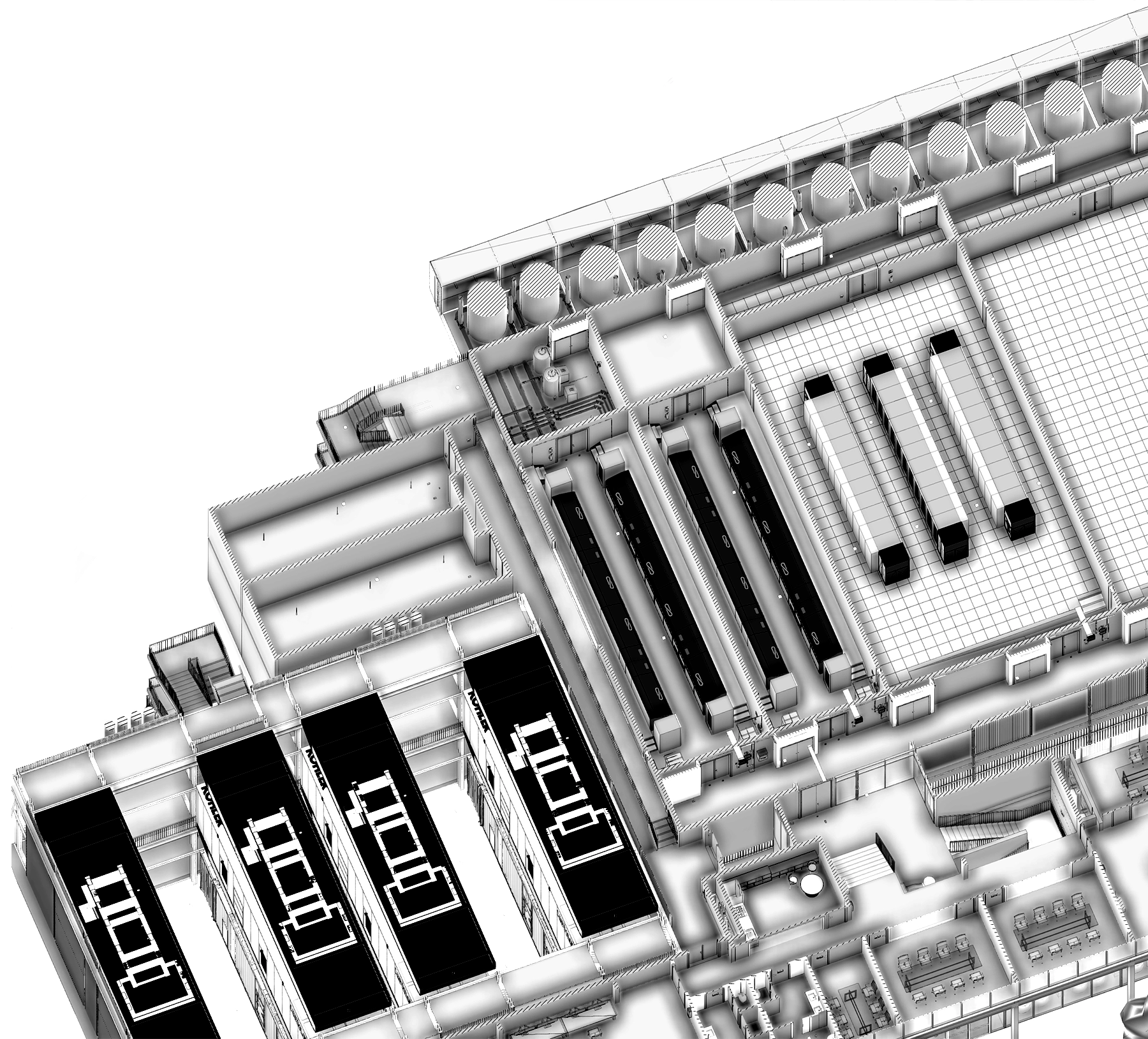Immersion CoolingEverything you need to know
Immersion cooling falls under the broader umbrella of liquid cooling technology. Liquid cooling refers to any method of removing heat from electronic components, such as CPUs or GPUs, by using a liquid coolant to absorb and transfer heat away from the hardware. In short, there are different types of liquid cooling solutions.
Under the category of liquid cooling, we'll find different approaches that include closed-loop systems, custom loop systems, direct liquid cooling (DLC), immersion cooling, and rear-door heat exchangers. At Submer, we offer liquid cooling at scale and specialize in immersion cooling and DLC. In this hub, we'll deep-dive into the world of immersion cooling.
When talking about immersion, we'll find two types of immersion cooling: single-phase immersion cooling and two-phase immersion cooling. Overall, immersion cooling has different applications for general and intensive workloads. Whether you are handling general tasks or pushing the limits of performance, immersion can be the ideal choice for both options.
This method has many benefits, especially environmentally friendly ones, as it enables datacenters to be managed in a greener and more sustainable way. In recent years, environmental concerns have been a huge catalyst for the adoption of this technology.
At Submer, we believe in green datacenters powered by liquid cooling solutions. Below, you will learn more about immersion cooling and its benefits. Whether you are new to the technique or consider yourself a pro, read on to discover something new!
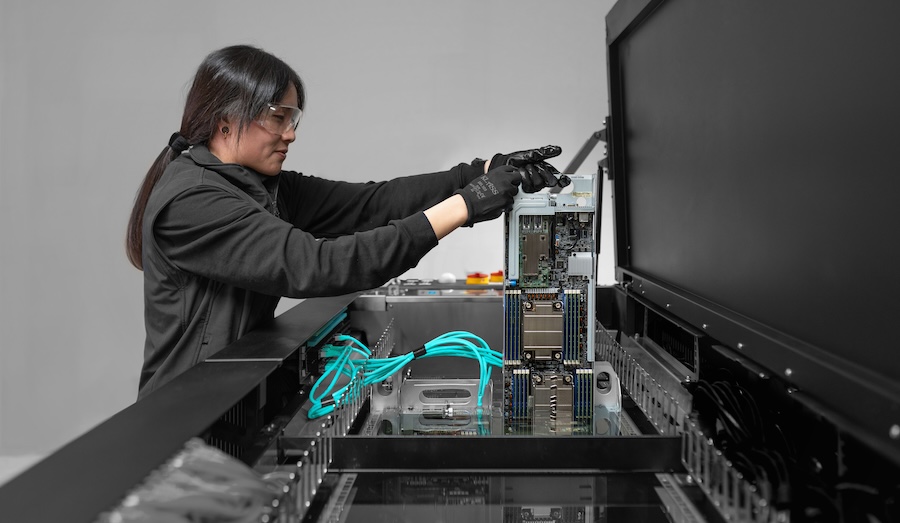
The Basics of Immersion Cooling
To better understand what immersion cooling can do for datacenters, we need to clarify what immersion cooling is, why we should apply immersion cooling, and how the technology works.
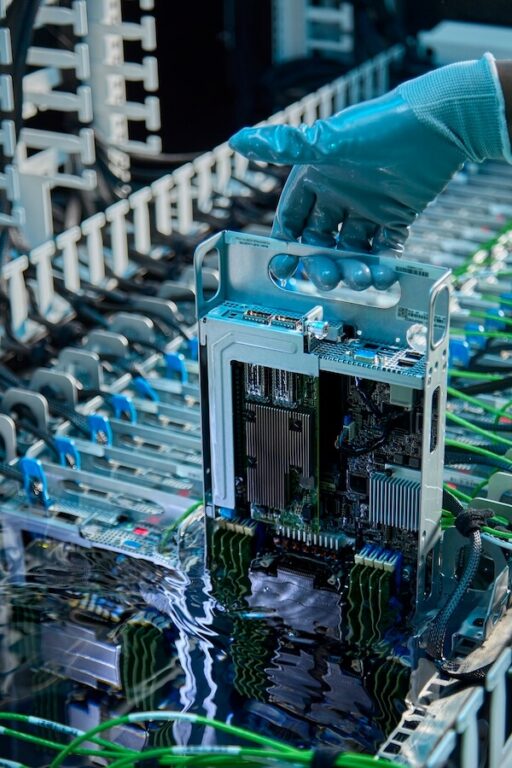
What Immersion Cooling Really Means
As we just mentioned, immersion cooling is a method that is becoming increasingly popular with innovative datacenters... but what makes the technique so popular and what differentiates it from the rest?
So, Why Immersion Cooling?
Immersion cooling could be the smart choice from both an operations point of view and a practical perspective.
- Immersion cooling simplifies datacenter commissioning.
- It makes datacenter maintenance easier.
- Deployment is fast and straightforward.
Furthermore, immersion cooling for datacenters makes sense from an environmental perspective.
According to the European Commission, in 2020 data centers consumed about 2% of the world’s electricity. By 2030, is expected this percentage is expected to grow to up to 8%.
The U.S. Environmental Protection Agency estimates that 28% of the water use in office buildings is for the cooling and heating system.
In what we consider a conventional datacenter, the amount of potable water consumed per year is up to 464,242,900.6992 litres.
The Benefits of Immersion Cooling
The practice of immersion cooling has a huge number of benefits, especially when it comes to sustainability and efficiency. Why is this important? These are two of the biggest challenges that the industry must overcome, both now and in the future. Immersion cooling significantly reduces the amount of water used, levels of carbon emissions, and much more.
Immersion cooling is scalable and modular
Overcome the challenges of space and scalability by implementing Immersion cooling within your infrastructure.
Immersion cooling can help to reduce the carbon footprint of your datacenter
Traditional datacenters use a high amount of fossil fuels to help power their cooling systems. Immersion requires significantly less power to run and to cool the IT servers and equipment, significantly reducing the amount of CO2 produced.
“This is the first of many examples to come of real symbiosis between datacenters, renewable energies, smart technology and a truly viable industrial application”.
How Immersion Cooling works
How does the immersion cooling system work? When choosing an immersion cooling system, servers are totally submerged in the dielectric coolant, but for this to happen, there’s an infrastructure in place. As the electronic components generate heat during operation, the coolant comes into direct contact with them. The heat from the components is transferred to the coolant through conduction.
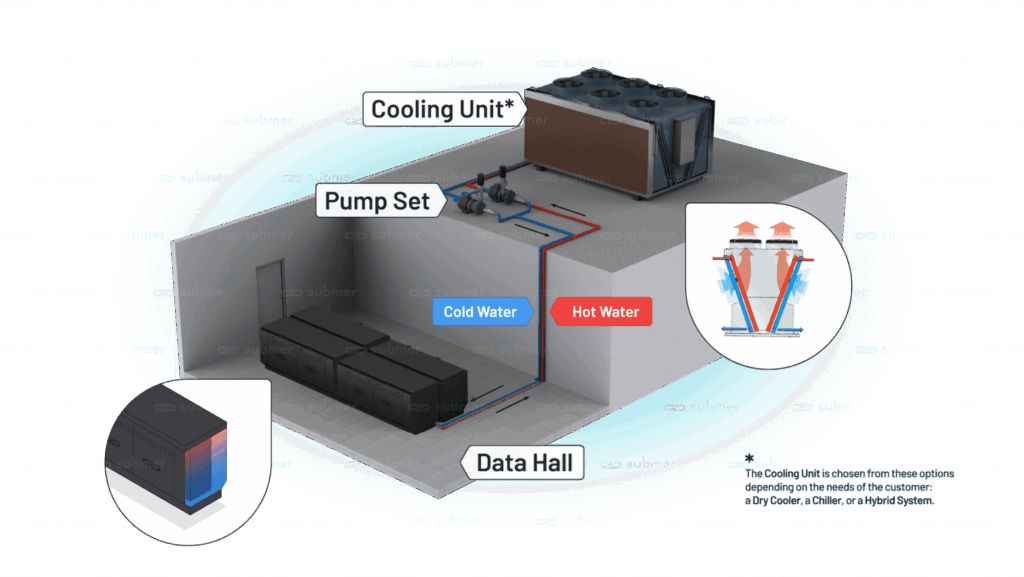
Types of Immersion Cooling
The two options of immersion cooling are single-phase and two-phase. In single-phase, the coolant stays liquid, never changes state, never boils, or freezes. In two-phase immersion, the coolant boils and condenses to transfer heat.
So, what are the key differences between single-phase and two-phase immersion cooling? Let's check the graphic below for more details.
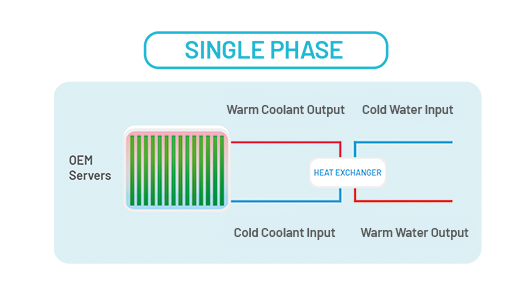
Single-Phase Immersion Cooling
Single-phase coolant never changes state, it never boils or freezes and always remains in a liquid form
Easier to access
Does not require a high level of maintenance
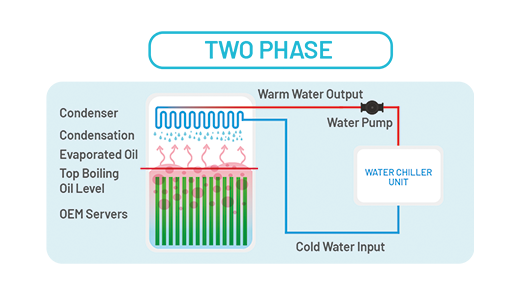
Two-Phase Immersion Cooling
In two-phase cooling, the working fluid boils and thus exists in both a liquid and gas phase
Complex to access
Requires more maintenance
In this scenario, our solutions are built on single-phase immersion cooling. The main reason we chose this technique is that it better aligns with our core values of sustainability and having a positive impact on the environment. How? Single-phase immersion cooling uses a biodegradable, non-toxic, non-flammable, non-corrosive liquid that has a lifespan longer than the average life of many datacenters. Overall, immersion offers a great balance of efficiency, simplicity and scalabiliy.
At Submer we explore each specific scenario and recommend the optimal liquid cooling approach based on your infrastructure, performance goals, and sustainability objectives.
Immersion Cooling: The Fluid
The reason behind why immersion cooling is more efficient than air cooling is, among others, because of the fluid. Why? The liquid is the key to how the heat is conducted. The choice of liquid is fundamental if the full benefits of immersion cooling are to be achieved.
Dielectric fluids are typically based on hydrocarbon compounds. The compounds can be from vegetable oils, mineral oils, fluorocarbons or other synthetic fluids. Dielectric liquids are classified depending on whether they are used within single-phase or two-phase immersion cooling.
- Which of these liquids will be compatible with my IT hardware?
- Which will be safe and easy to work with?
- Which one has the longest life-span?
- Which of these liquids will be compatible with my IT hardware?
- Will the liquid impact the environment in the future?
- Which of these liquids will be compatible with my IT hardware?
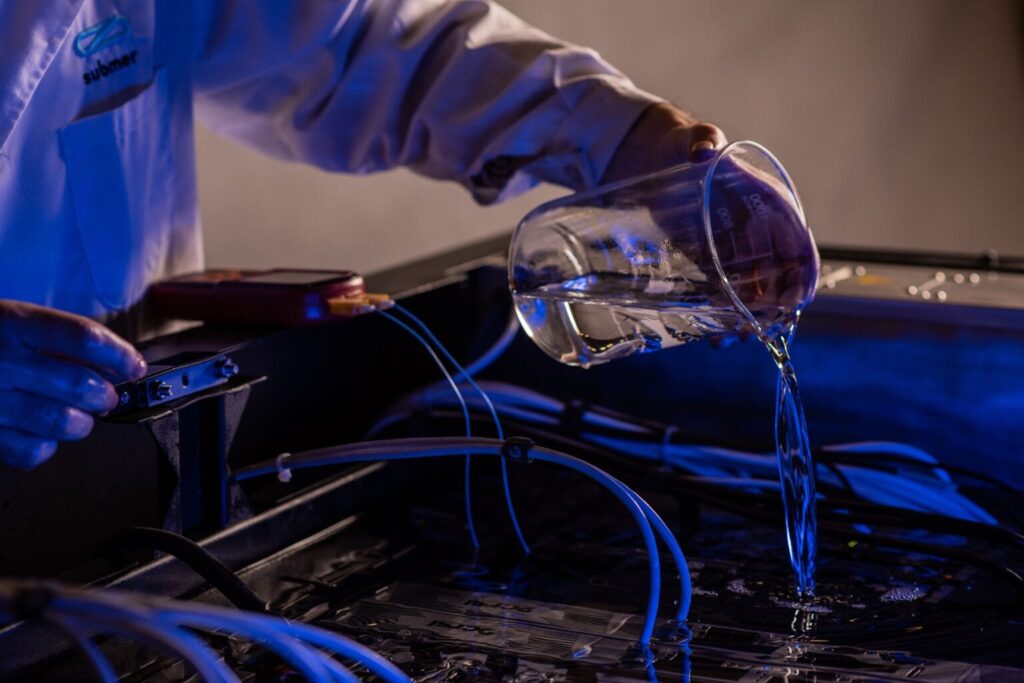
Immersion Cooling Applications
Immersion cooling offers a wide range of applications. Whether we are looking to maximize operational efficiency or transform challenges into advantages, immersion cooling can meet unique requirements. It works well for all kinds of workloads, from everyday tasks like web hosting to heavy computing jobs like data analysis or scientific simulations. It efficiently cools systems, lowers energy use and noise, and supports dense setups, making single-phase immersion cooling a smart choice for companies wanting reliable and sustainable cooling.
Cooling General Workloads With Immersion
If you’re driven by efficiency, looking to scale up, or interested in improving the sustainability of your datacenter, our immersion cooling solutions have you covered for general workloads.
- Cloud Computing
- Web Hosting Workloads
- Backup and Storage/ Email Servers
- Virtualization
Immersion Cooling for Intensive Workloads
Immersion cooling for high density compute workloads is the most efficient way to meet the needs of today’s AI-driven landscape. Whether your focus is on CPUs or GPUs, match the high Thermal Design Power (TDP) with our high-performance solutions.
-
Data Analytics & Scientific Simulations.
- Artificial Intelligence & Machine Learning.
- High-Performance Computing (HPC).
- Transactional Workloads.
- Virtual Desktops.
Immersion Cooling: The Products
Our Immersion cooling products are part of our ‘Submer Cools‘ brand. We have designed a range of modular solutions that empower users to effortlessly scale their operations while simultaneously saving space and energy and increasing compute capacity. Currently, there are three core products, available in a variety of sizes allowing us to cater to every company’s specific needs and requirements.
SmartPod EVO
The SmartPod EVO is the latest evolution of our flagship product and the easiest path to immersion cooling. This compact solution is the perfect solution for plug & play immersion at scale. Packing 140 kW+ of heat dissipation capacity, the SmartPod EVO does so while reducing your environmental footprint. Choose between single or dual CDUs for optimal performance. Key benefits of the SmartPod EVO include:
- Efficiency and sustainability
- Ease of deployment
- Smooth and predictable daily IT operations
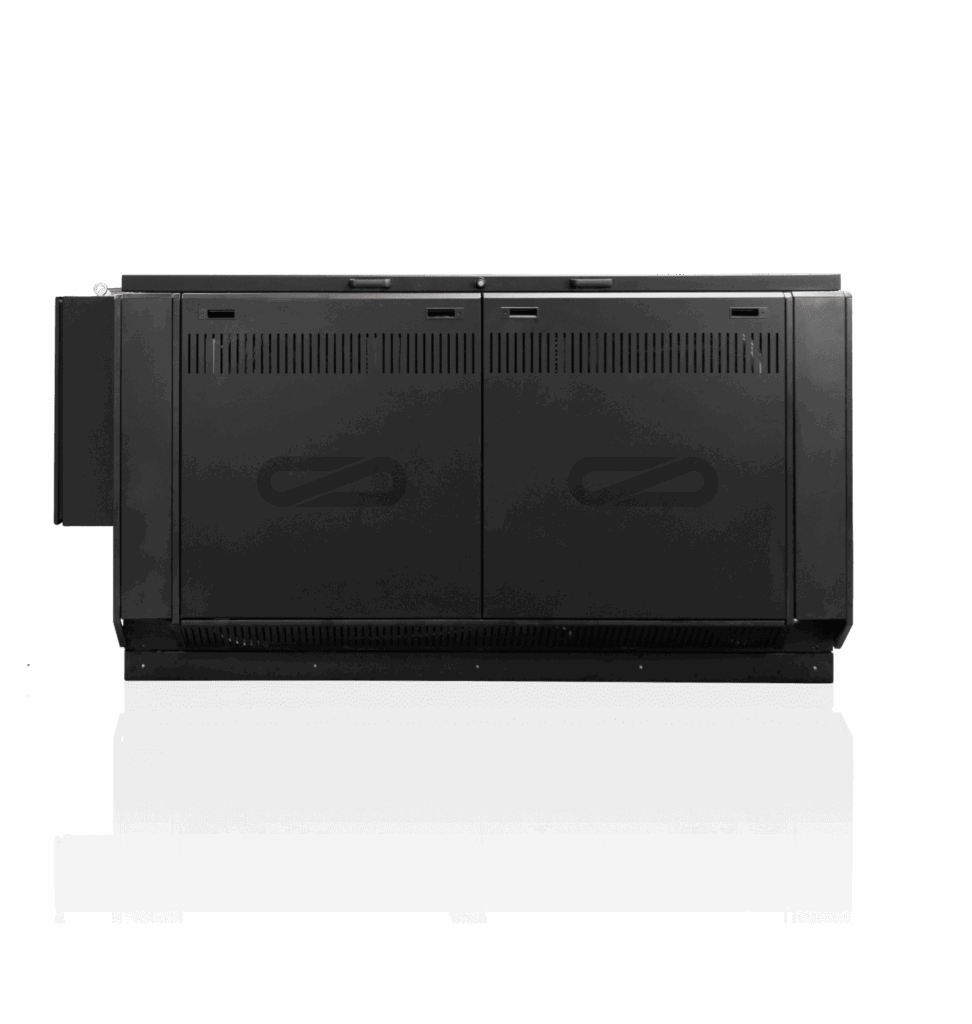
SmartPod EXO
The SmartPod EXO is our immersion cooling technology product designed to meet extreme density needs, offering exceptional performance for datacenters. The EXO is also a climate-resilient solution, which means this product helps data centers achieve sustainability goals and future-proof facilities. More reasons make the SmartPod EXO the perfect solution to meet today's datacenter.
-
More heat dissipation capacity.
-
Straightforward IT operations.
-
Remote system management.
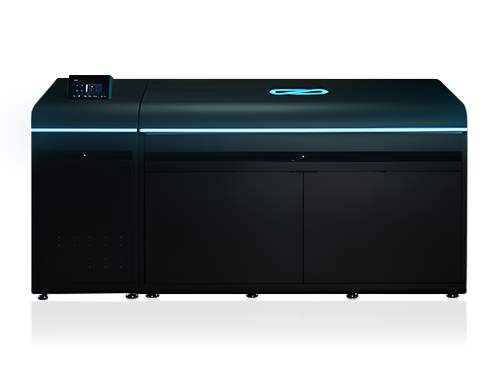
MicroPod
The MicroPod is our Edge-ready datacenter in-a-box. Built specifically to target the increasing needs of companies that need to bring their infrastructure closer to the customer such as telecommunications, streaming, or cloud computing. Purpose-built to be extremely flexible and modular, the MicroPod has integrated secondary cooling and up to 7kW of heat dissipation. Be it a warehouse, office building, in the heart of a city or in a remote area with harsh-climate conditions and far from the grid, the MicroPod will be fit for the job.
Other benefits of the MicroPod include:
- Low energy footprint
- Reduction of Total Cost of Ownership (TCO)
- Zero water consumption
- Increase hardware lifespan
- Dramatic OPEX reduction
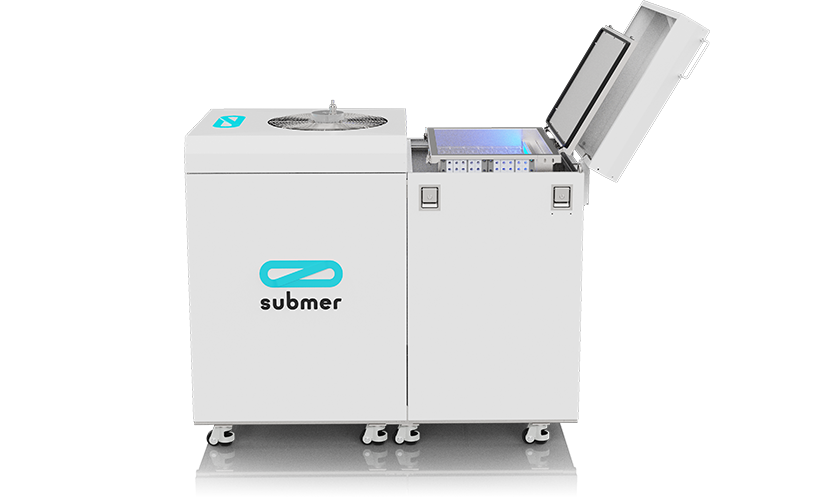
Sources
- Deru, M., & Bonnema, E. (2019, 16 agosto). Testing and Evaluation of a Chemical-Free Cooling Tower Water Treatment Technology. Osti.Gov. https://www.osti.gov/biblio/1558360-testing-evaluation-chemical-free-cooling-tower-water-treatment-technology
- EU Eyes Carbon-Neutral Data Centers by 2030 in Green-Tech Switch. (2020, 6 febrero). Data Center Knowledge. https://www.datacenterknowledge.com/energy/eu-eyes-carbon-neutral-data-centers-2030-green-tech-switch
- Mezzanotte – Pr, M. C. \. C. M. V. B. S. (2020, 8 septiembre). Submer: When Datacenters really Start to Make Sense. Data Center Knowledge. https://www.datacenterknowledge.com/industry-perspectives/submer-when-datacenters-really-start-make-sense
- Qin, Y. (2020). Micro-Manufacturing Engineering and Technology. Sciencedirect.Com. https://www.sciencedirect.com/book/9780815515456/micro-manufacturing-engineering-and-technology
